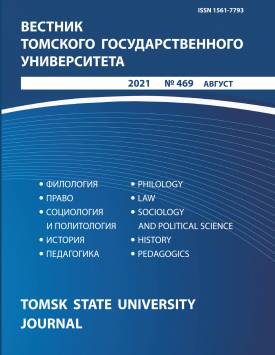The Documentary Basis and Work With Facts in Feliks Volkhovsky's Feuilletons (1882-1884)
The article discusses the issue of working with facts in feuilletons by Feliks Volkhovsky, the leading employee of the Tomsk prerevolutionary Sibirskaya Gazeta. For periodicals in Siberia at the end of the 19th century, a characteristic method of working with facts was the creation of feuilletons on their basis: the texts of local feuilletonists relied on city, national, and world news; they affected the economic, sociopolitical, and cultural spheres of life bypassing preliminary censorship. The aim of the study is to identify the documentary basis of satirical genres in pre-revolutionary Siberian periodicals. The research material is Volkhovsky's feuilletons published in Sibirskaya Gazeta in 1882-1884. The work uses the method of genre research, the method of genre analysis, the narrative method, and content analysis. The study compares the news selections of Sibirskaya Gazeta with the substantive part of the feuilletons, classifies methods of working with facts and presenting them in feuilleton texts. Relying on city and all-Russian news presented in texts in different formats, feuilletons acquired a documentary basis, became an important fact of social life in Siberia. In the article, the author comes to the conclusion that most of Volkhovsky's feuilletons had a documentary basis created as a result of his work with facts obtained from various sources. Eyewitness accounts, letters from the field, newspaper and magazine publications that attracted Volkhovsky's attention, rumors, statistics - all this served as material for comprehending and forming a feuilleton plot. As a result of literary processing, factual data most often lost their specificity: people's and geographical names were replaced or abbreviated, the place of action was transferred to a fictional city, etc. This made it possible to bypass censorship restrictions and bring up an important public problem for discussion without violating the established rules. However, the readers of Sibirskaya Gazeta easily deciphered allegories and substitutions, recognizing real characters in imaginary ones, reconstructing events by individual features. The documentary basis of Volkhovsky's feuilletons and their artistic component were in an indissoluble unity, which made it possible to work most effectively with the newspaper's audience. The forced lack of specifics intensified the emotional impact on readers, since the impact was provided with the help of images created as a result of typification and generalization. This also allows speaking of Volkhovsky's feuilletons as a special format of Siberian journalism that was limited by the framework of preliminary censorship, but used all means to raise important public issues.
Keywords
feuilleton, news, fact, F.V. Volkhovsky, Sibirskaya GazetaAuthors
| Name | Organization | |
| Mazurov Alexandr E. | Tomsk State University | rumatamonteg@gmail.com |
References

The Documentary Basis and Work With Facts in Feliks Volkhovsky's Feuilletons (1882-1884) | Vestnik Tomskogo gosudarstvennogo universiteta – Tomsk State University Journal. 2021. № 469. DOI: 10.17223/15617793/469/3
